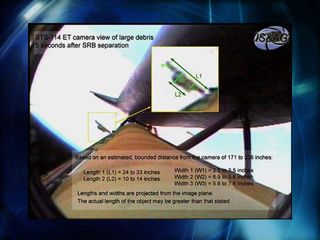NASA Nixes Foam Ramp for Next Space Shuttle Flight

NASA willnot fly a protective foam ramp aboard the fuel tank for its next space shuttle mission,eliminating a potential launch debris hazard that croppedup during July's launch of the Discovery orbiter, a top agency officialsaid Thursday.
Flying NASA'sSTS-121 shuttle mission - the second flight since the 2003 Columbia accident - withoutthe ramp could push the spaceflight past a May2006 launch window depending on the extent of modifications required, said WilliamGerstenmaier, NASA's associate administrator for space operations, in ateleconference with reporters.
Engineershave been discussingwhether remove a protective protuberance air load (PAL) ramp from shuttle fueltanks since July, when a one-pound chunk of foam insulation popped free fromthe ramp during Discovery's STS-114launch. A similar foam shedding event doomed the space shuttle Columbia and itsseven-astronaut crew in 2003 when it damaged the orbiter's heat shield.
"We thinkthat's the best thing to do, just take it off," Gerstenmaier said, adding thatmeeting a May 2006 launch window comes second to solving the PAL ramp issues. "Ithink we ought not to think about May right now."
Last month,NASA shuttle officials said investigators had discovered a series of finecracks along the PAL ramp of External Tank 120 (ET-120), which has beenfilled twice with supercold liquid fuel during tests and is one of severalunder scrutiny.
"We know alot about the cracking phenomenon, but we still haven't pinpointed the cause," Gerstenmaiersaid, adding that solving the problem is critical not just for STS-121, butlong-term shuttle program through its 2010 retirement date. "We know it'srelated to the chill down process and to some pressurization of the tank, buthow those fit together...it's not an easy problem."
Once theproblem is better understood, engineers will then decide the best fix for theexternal tank.
Get the Space.com Newsletter
Breaking space news, the latest updates on rocket launches, skywatching events and more!
"We'regoing to do the right thing and let the data drive us where we need to go,"Gerstenmaier said. "I think we've got a unique opportunity to get this right."
- NASA's PAL Ramp Foam Problem a Lesson in Failure, Shuttle Chief Says
- Special Report: NASA's STS-114 Return to Flight Shuttle Mission
Join our Space Forums to keep talking space on the latest missions, night sky and more! And if you have a news tip, correction or comment, let us know at: community@space.com.

Tariq is the Editor-in-Chief of Space.com and joined the team in 2001, first as an intern and staff writer, and later as an editor. He covers human spaceflight, exploration and space science, as well as skywatching and entertainment. He became Space.com's Managing Editor in 2009 and Editor-in-Chief in 2019. Before joining Space.com, Tariq was a staff reporter for The Los Angeles Times covering education and city beats in La Habra, Fullerton and Huntington Beach. In October 2022, Tariq received the Harry Kolcum Award for excellence in space reporting from the National Space Club Florida Committee. He is also an Eagle Scout (yes, he has the Space Exploration merit badge) and went to Space Camp four times as a kid and a fifth time as an adult. He has journalism degrees from the University of Southern California and New York University. You can find Tariq at Space.com and as the co-host to the This Week In Space podcast with space historian Rod Pyle on the TWiT network. To see his latest project, you can follow Tariq on Twitter @tariqjmalik.
